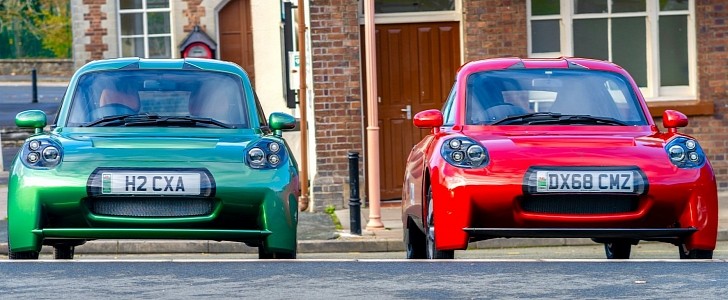When Riversimple first announced its plans many years ago, it was dismissed by many as a waste of public money. The fact that the company is still around promoting its ideas – not only for personal transportation but also for the current economic model – shows it will not stop despite criticism. The Welsh company may be about to take its major step so far: reaching California.
That possibility came after Riversimple disclosed its membership to the CMC (California Mobility Center). The non-profit public-private business acceleration hub was created in March 2021 to provide transportation companies with “a faster path to commercializing their products, services, and technologies in the California(n) market and, thus, across the globe.”
For Riversimple, it may be the perfect opportunity to demonstrate its business model to one of the most important car makers in the world. More than the U.S., California is a trendsetter and also an environmentally-friendly technologies champion. It is not a coincidence that it is one of the few American states with hydrogen refueling stations, something that can be incredibly handy for the Welsh company.
If you are not familiar with Riversimple, it is probably the first car company that does not sell vehicles. It does not think that selling is an intelligent business model, especially considering how that induces a higher consumption of raw materials. This is the reason for Earth Overshoot Day to happen sooner each year. This date tries to warn how fast mankind depletes the resources the planet can produce every year. In 1970, it happened on December 30. In 2021, on July 19.
What Riversimple proposes is that you pay to use its cars. The monthly fee will include everything: from fuel (hydrogen) to insurance, from servicing to taxes. If their cars are not efficient, it is Riversimple who pays for that. If they are not reliable, the Welsh company’s pockets are the ones that are going to hurt.
By embracing these worries instead of leaving them for regular customers (as current cars do), Riversimple makes these aspects key advantages for the company’s business model. On top of that, it offers what it calls a network electric car. Thanks to ultracapacitors, it can harvest all the energy from regenerative braking. These components also provide the FCEV with enough power in accelerations not to increase hydrogen consumption.
If Californians are ok to drive a tiny two-seater around, the company may consider offering the Rasa in that American state. Hugo Spowers – Riversimple’s managing director – mentioned the CMC partnership “will accelerate our development of hydrogen vehicles specifically for the U.S. market,” which probably means we will see something other than the Rasa around there.
Even if only a few people would consider the Rasa, Riversimple’s factories are not big. Employing around 220 people to make 5,000 cars per year, the Welsh company would need a lot of them to reach a massive scale. The idea now seems to be presenting the concept and scaling up when the demand increases.
California currently has 13,000 vehicles powered by hydrogen and 52 filling stations, with 120 in development. In other words, it may be the perfect place for Riversimple to demonstrate the feasibility of its business model without the need to create the necessary infrastructure. It will be entertaining to hear the critics in the process.
For Riversimple, it may be the perfect opportunity to demonstrate its business model to one of the most important car makers in the world. More than the U.S., California is a trendsetter and also an environmentally-friendly technologies champion. It is not a coincidence that it is one of the few American states with hydrogen refueling stations, something that can be incredibly handy for the Welsh company.
If you are not familiar with Riversimple, it is probably the first car company that does not sell vehicles. It does not think that selling is an intelligent business model, especially considering how that induces a higher consumption of raw materials. This is the reason for Earth Overshoot Day to happen sooner each year. This date tries to warn how fast mankind depletes the resources the planet can produce every year. In 1970, it happened on December 30. In 2021, on July 19.
What Riversimple proposes is that you pay to use its cars. The monthly fee will include everything: from fuel (hydrogen) to insurance, from servicing to taxes. If their cars are not efficient, it is Riversimple who pays for that. If they are not reliable, the Welsh company’s pockets are the ones that are going to hurt.
By embracing these worries instead of leaving them for regular customers (as current cars do), Riversimple makes these aspects key advantages for the company’s business model. On top of that, it offers what it calls a network electric car. Thanks to ultracapacitors, it can harvest all the energy from regenerative braking. These components also provide the FCEV with enough power in accelerations not to increase hydrogen consumption.
If Californians are ok to drive a tiny two-seater around, the company may consider offering the Rasa in that American state. Hugo Spowers – Riversimple’s managing director – mentioned the CMC partnership “will accelerate our development of hydrogen vehicles specifically for the U.S. market,” which probably means we will see something other than the Rasa around there.
Even if only a few people would consider the Rasa, Riversimple’s factories are not big. Employing around 220 people to make 5,000 cars per year, the Welsh company would need a lot of them to reach a massive scale. The idea now seems to be presenting the concept and scaling up when the demand increases.
California currently has 13,000 vehicles powered by hydrogen and 52 filling stations, with 120 in development. In other words, it may be the perfect place for Riversimple to demonstrate the feasibility of its business model without the need to create the necessary infrastructure. It will be entertaining to hear the critics in the process.
























